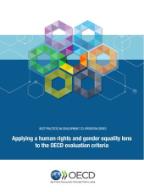|
It is important that the definitions of the criteria are understood within a broader context, and read in conjunction with other principles and guidance on how to conduct evaluations in ways that will be useful and of high quality
Principle One
The criteria should be applied thoughtfully to support high quality, useful evaluation.
They should be contextualized – understood in the context of the individual evaluation, the intervention being evaluated, and the stakeholders involved. The evaluation questions (what you are trying to find out) and what you intend to do with the answers, should inform how the criteria are specifically interpreted and analysed.
|
Principle Two
The use of the criteria depends on the purpose of the evaluation. The criteria should not be applied mechanistically.
Instead, they should be covered according to the needs of the relevant stakeholders and the context of the evaluation. More or less time and resources may be devoted to the evaluative analysis for each criterion depending on the evaluation purpose. Data availability, resource constraints, timing, and methodological considerations may also influence how (and whether) a particular criterion is covered.
|
|
The six evaluation criteria explained
RELEVANCE
IS THE INTERVENTION DOING THE RIGHT THINGS?
|
The extent to which the intervention objectives and design respond to beneficiaries , global, country, and partner/institution needs, policies, and priorities, and continue to do so if circumstances change.
Note: “Respond to” means that the objectives and design of the intervention are sensitive to the economic, environmental, equity, social, political economy, and capacity conditions in which it takes place. “Partner/institution” includes government (national, regional, local), civil society organisations, private entities and international bodies involved in funding, implementing and/or overseeing the intervention. Relevance assessment involves looking at differences and trade-offs between different priorities or needs. It requires analysing any changes in the context to assess the extent to which the intervention can be (or has been) adapted to remain relevant.
* Beneficiaries is defined as, “the individuals, groups, or organisations, whether targeted or not, that benefit directly or indirectly, from the development intervention." Other terms, such as rights holders or affected people, may also be used.
|
COHERENCE
HOW WELL DOES THE INTERVENTION FIT?
|
The compatibility of the intervention with other interventions in a country, sector or institution.
Note: The extent to which other interventions (particularly policies) support or undermine the intervention, and vice versa. Includes internal coherence and external coherence: Internal coherence addresses the synergies and interlinkages between the intervention and other interventions carried out by the same institution/government, as well as the consistency of the intervention with the relevant international norms and standards to which that institution/government adheres. External coherence considers the consistency of the intervention with other actors’ interventions in the same context. This includes complementarity, harmonisation and co-ordination with others, and the extent to which the intervention is adding value while avoiding duplication of effort.
|
EFFECTIVENESS
IS THE INTERVENTION ACHIEVING ITS OBJECTIVES?
|
The extent to which the intervention achieved, or is expected to achieve, its objectives, and its results, including any differential results across groups.
Note: Analysis of effectiveness involves taking account of the relative importance of the objectives or results.
|
EFFICIENCY
HOW WELL ARE RESOURCES BEING USED?
|
The extent to which the intervention delivers, or is likely to deliver, results in an economic and timely way.
Note: “Economic” is the conversion of inputs (funds, expertise, natural resources, time, etc.) into outputs, outcomes and impacts, in the most cost-effective way possible, as compared to feasible alternatives in the context. “Timely” delivery is within the intended timeframe, or a timeframe reasonably adjusted to the demands of the evolving context. This may include assessing operational efficiency (how well the intervention was managed).
|
IMPACT
WHAT DIFFERENCE DOES THE INTERVENTION MAKE?
|
The extent to which the intervention has generated or is expected to generate significant positive or negative, intended or unintended, higher-level effects.
Note: Impact addresses the ultimate significance and potentially transformative effects of the intervention. It seeks to identify social, environmental and economic effects of the intervention that are longer term or broader in scope than those already captured under the effectiveness criterion. Beyond the immediate results, this criterion seeks to capture the indirect, secondary and potential consequences of the intervention. It does so by examining the holistic and enduring changes in systems or norms, and potential effects on people’s well-being, human rights, gender equality, and the environment.
|
SUSTAINABILITY
WILL THE BENEFITS LAST?
|
The extent to which the net benefits of the intervention continue, or are likely to continue.
Note: Includes an examination of the financial, economic, social, environmental, and institutional capacities of the systems needed to sustain net benefits over time. Involves analyses of resilience, risks and potential trade-offs. Depending on the timing of the evaluation, this may involve analysing the actual flow of net benefits or estimating the likelihood of net benefits continuing over the medium and long-term.
|
|


